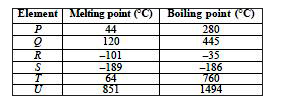The table shows the melting points and boiling points of six elements P, Q, R, S, T and U. These elements represent consecutive members of periods 3 and 4 of the periodic table.

0.2 mol of the chloride of element U reacts with excess of silver nitrate to form 57.4 g of silver chloride. The formula of chloride is (Given : Atomic mass of N = 14 u, O = 16 u, CI = 35.5 u, Ag = 108 u)
Ucl
UCl2
UCl3
UCl5
The correct Answer is:B
Step by step video & image solution for The table shows the melting points and boiling points of six elements P, Q, R, S, T and U. These elements represent consecutive members of periods 3 and 4 of the periodic table. 0.2 mol of the chloride of element U reacts with excess of silver nitrate to form 57.4 g of silver chloride. The formula of chloride is (Given : Atomic mass of N = 14 u, O = 16 u, CI = 35.5 u, Ag = 108 u) by Chemistry experts to help you in doubts & scoring excellent marks in Class 10 exams.
Updated on:21/07/2023Topper's Solved these Questions
- NSO QUESTION PAPER 2016 SET B Book:SCIENCE OLYMPIAD FOUNDATION Chapter:NSO QUESTION PAPER 2016 SET B Exercise:Achievers Section
Explore 2 Videos
- NSO QUESTION PAPER 2016 SET ABook:SCIENCE OLYMPIAD FOUNDATION Chapter:NSO QUESTION PAPER 2016 SET AExercise:Achievers Section
Explore 3 Videos
- NSO QUESTION PAPER 2017 SET ABook:SCIENCE OLYMPIAD FOUNDATION Chapter:NSO QUESTION PAPER 2017 SET AExercise:Achievers Section
Explore 2 Videos
Similar Questions
The table shows the melting points and boiling points of six elements P, Q, R, S, T and U. These elements represent consecutive members of periods 3 and 4 of the periodic table.

If S is a noble gas, then the bond formed between T and R is
View SolutionAn element "X" belongs to group "15" and "2"nd period in the periodic table the atomic number of elements is
View Solution
Knowledge Check
When 0.01 mole of a cobalt complex is treated with excess of silver nitrate solution 4.035 g of silver chloride is precipitated. The formula of the complex is :
A[Co(NH3)3Cl3]B[Co(NH3)5Cl]Cl2C[Co(NH3)6]Cl3D[Co(NH3)4Cl2]NO3When 0.01 mole of a cobalt complex is treated with excess of silver nitrate solution 4.035 g of silver chloride is precipitated. The formula of the complex is :
A[Co(NH3)3Cl3]B[Co(NH3)5Cl]Cl2C[Co(NH3)6]Cl3D[Co(NH3)4Cl2]NO3Which 0.01 mole of a cobalt complex is treated with excess silver nitralte solution4.305 g silver chloride is precipitated. The formula of the complex is
A[Co(NH3)3Cl3]B[Co(NH3)5Cl]Cl2C[Co(NH3)6]Cl3D[Co(NH3)4Cl2]No3
The element having lowest melting point in periodic table is
View SolutionElement of atomic number 23 is placed in the periodic table in
View SolutionWhen two moles of [Co(NH3)5Cl]Cl2 is treated with excess silver nitrate solution, the number of moles of silver chloride formed is
View SolutionThe number of elements in the 4th period of periodic table is
View SolutionThe number of elements in the 4th period of periodic table is
View Solution

